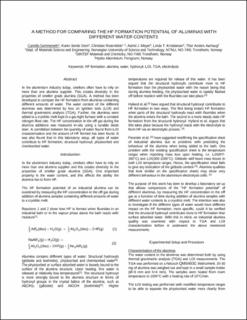| dc.contributor.author | Sommerseth, Camilla | |
| dc.contributor.author | Osen, Karen Sende | |
| dc.contributor.author | Rosenkilde, Christian | |
| dc.contributor.author | Meyer, Astrid J. | |
| dc.contributor.author | Kristiansen, Linda | |
| dc.contributor.author | Aarhaug, Thor Anders | |
| dc.date.accessioned | 2020-12-22T11:41:00Z | |
| dc.date.available | 2020-12-22T11:41:00Z | |
| dc.date.created | 2012-05-25T11:17:05Z | |
| dc.date.issued | 2012 | |
| dc.identifier.citation | Light Metals. 2012, 827-832. | en_US |
| dc.identifier.issn | 0147-0809 | |
| dc.identifier.uri | https://hdl.handle.net/11250/2720753 | |
| dc.description.abstract | In the aluminium industry today, smelters often have to rely on more than one alumina supplier. This creates diversity in the properties of smelter grade alumina (SGA). A method has been developed to compare the HF formation from aluminas containing different amounts of water. The water content of the different aluminas was determined by loss on ignition tests (LOI) and thermal gravimetric analysis (TGA). Further, the aluminas were added to a cryolitic melt kept in a gas tight furnace with a constant nitrogen flow rate. The HF concentration in the off gas during the alumina additions was measured in-situ using a tunable diode laser. A correlation between the quantity of water found from LOI characterisation and the amount of HF formed has been found. It was also found that in this laboratory setup, all types of water contribute to HF formation; structural hydroxyl, physisorbed and chemisorbed water. | en_US |
| dc.language.iso | eng | en_US |
| dc.publisher | Springer | en_US |
| dc.relation.ispartofseries | The Minerals, Metals & Materials Series;2367-1181 | |
| dc.subject | electrolysis | en_US |
| dc.subject | TGA | en_US |
| dc.subject | LOI | en_US |
| dc.subject | hydroxyl | en_US |
| dc.subject | water | en_US |
| dc.subject | alumina | en_US |
| dc.subject | HF formation | en_US |
| dc.title | A method for comparing the HF formation potential of aluminas with different water contents | en_US |
| dc.type | Peer reviewed | en_US |
| dc.type | Journal article | en_US |
| dc.description.version | acceptedVersion | en_US |
| dc.rights.holder | This is a post-peer-review, pre-copyedit version of an article published in Light Metals 2012. The final authenticated version is available online at: https://doi.org/10.1002/9781118359259.ch143 | en_US |
| dc.source.pagenumber | 827-832 | en_US |
| dc.source.journal | Light Metals 2012 | en_US |
| dc.identifier.doi | 10.1002/9781118359259.ch143 | |
| dc.identifier.cristin | 926366 | |
| dc.relation.project | Norges forskningsråd: 182617 | en_US |
| cristin.unitcode | 7401,80,4,1 | |
| cristin.unitcode | 7401,80,3,1 | |
| cristin.unitname | Prosess- og metallurgilaboratoriet | |
| cristin.unitname | Nye energiløsninger | |
| cristin.ispublished | true | |
| cristin.fulltext | postprint | |
| cristin.qualitycode | 1 | |
